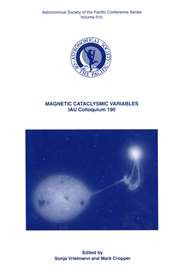No CrossRef data available.
Article contents
δ Sct-Type Pulsators in Eclipsing Binary Systems: the Case of RZ Cas
Published online by Cambridge University Press: 12 April 2016
Abstract
Core share and HTML view are not available for this content. However, as you have access to this content, a full PDF is available via the ‘Save PDF’ action button.
RZ Cas is an Algol-type eclipsing binary system where the primary component was recently discovered as a δ Set pulsator. A three-continent multisite photometric campaign was carried out during 1999. Preliminary results are reported here indicating a semi-detached system where the secondary fills its Roche lobe. The light curves also suggest a hot spot on the surface of the primary component as a consequence of the impact of the mass stream from the secondary. The pulsational behaviour can be well described with only one frequency.
Information
- Type
- Part 1.2. Pulsations in Close Binaries
- Information
- Copyright
- Copyright © Astronomical Society of the Pacific 2002

